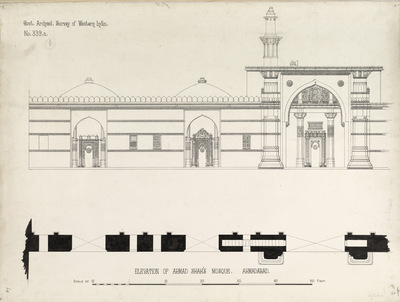Javascript must be enabled to continue!
Ahmadabad: Elevation of Ahmad Shah's mosque
View through Europeana Collections
Elevation illustration of Ahmad Shah's mosque in
Ahmadabad, Gujarat from James Burgess' 'Original Drawings [of]
Muhammadan Architecture of Ahmadabad.' Sultan Ahmad Shah
(r.1411-42) founded the city of Ahmadabad in 1411 and was
responsible for the construction of several buildings and mosques.
His Ahmad Shah mosque, also known as the Chhoti Jumna Mosque, was
built in Ahmadabad's citadel and completed in 1414. An Arabic
inscription over the central mihrab records that the mosque was
built by Ahmad Shah in 1414. The ground plan of the Ahmad Shah
mosque is based on the Jami Masjid in Cambay, built in 1325. The
roof is covered with ten large domes and other smaller ones
between. Key features of this mosque include the eight
perforated stone windows which light the interior and the use of
pillars, which originated from an earlier Hindu temple, to support
the domes which demonstrate the fusion of Islamic and Hindu
architectural styles. Inscribed: 'Government Archaeological Survey
of Western India. No. 339a'
Title: Ahmadabad: Elevation of Ahmad Shah's mosque
Description:
Elevation illustration of Ahmad Shah's mosque in
Ahmadabad, Gujarat from James Burgess' 'Original Drawings [of]
Muhammadan Architecture of Ahmadabad.
' Sultan Ahmad Shah
(r.
1411-42) founded the city of Ahmadabad in 1411 and was
responsible for the construction of several buildings and mosques.
His Ahmad Shah mosque, also known as the Chhoti Jumna Mosque, was
built in Ahmadabad's citadel and completed in 1414.
An Arabic
inscription over the central mihrab records that the mosque was
built by Ahmad Shah in 1414.
The ground plan of the Ahmad Shah
mosque is based on the Jami Masjid in Cambay, built in 1325.
The
roof is covered with ten large domes and other smaller ones
between.
 Key features of this mosque include the eight
perforated stone windows which light the interior and the use of
pillars, which originated from an earlier Hindu temple, to support
the domes which demonstrate the fusion of Islamic and Hindu
architectural styles.
Inscribed: 'Government Archaeological Survey
of Western India.
No.
339a'.
Related Results
Malik Shah Rustam in the Presence of Shah Isma'il, illustrated folio from a manuscript of the Tarikh-i `Alamara-yi Shah Isma`il
Malik Shah Rustam in the Presence of Shah Isma'il, illustrated folio from a manuscript of the Tarikh-i `Alamara-yi Shah Isma`il
This is a folio with painting that has been detached from a manuscript of theTarikh-i `Alamara-yi Shah Isma`il. Four lines of Persian in nastal'iq script frame a painting of figure...
The Great Mosque of Delhi, India. Novr. 1878
The Great Mosque of Delhi, India. Novr. 1878
Oil painting on paper of the Great Mosque at
Delhi by Marianne North (1830-1890), dated November 1878. A number
of cities have been built in the vicinity of Delhi on the banks of
t...
Mughal emperor Shah Jahan receives a sparrowhawk from Raja Prithvi Singh of Chamba
Mughal emperor Shah Jahan receives a sparrowhawk from Raja Prithvi Singh of Chamba
In this painting, the Mughal emperor Shah Jahan (r.1627-1658) receives a sparrowhawk from ruler Raja Prithvi Singh of Chamba (1641-64), located in Himachal Pradesh. Shah Jahan’s i...
Firman of Muhammad Shah Qajar
Firman of Muhammad Shah Qajar
This firman (royal decree) is from Muhammad Shah Qajar (r. 1834-48). It is addressed to Mu`tamid al-Dawla, the governor of Isfahan; it transfers to Mirza Husayn Khan, the governo...
Pen Box with Muhammad Shah Qajar and Nur `Ali Shah
Pen Box with Muhammad Shah Qajar and Nur `Ali Shah
Rectangular box with lift-off lid secured by a chain. The exterior of the lid is decorated in vertical format with a portrait of Muhammad Shah Qajar (r. 1834 48) seated on a chair ...
Dala'il al-Khayrat Prayer Book
Dala'il al-Khayrat Prayer Book
Manuscript: Ink opaque watercolor and gold on paper
Binding: Gilt tooled morocco...




